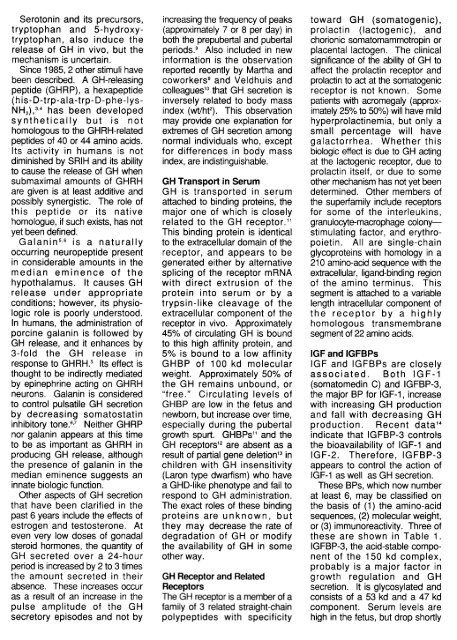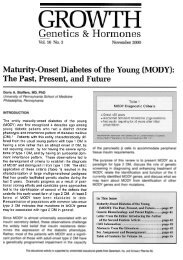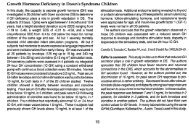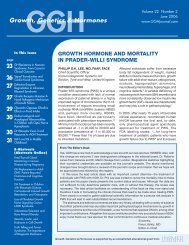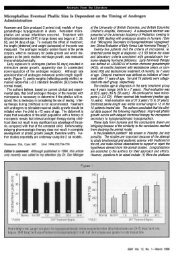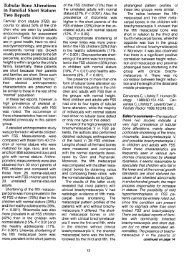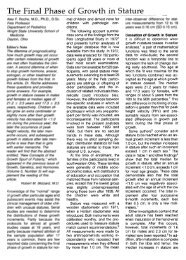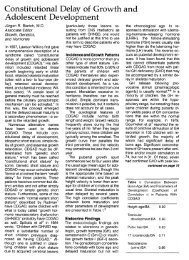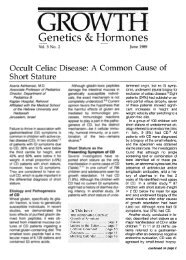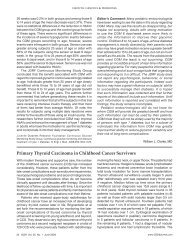an update: growth hormone physiology and ... - GGH Journal
an update: growth hormone physiology and ... - GGH Journal
an update: growth hormone physiology and ... - GGH Journal
Create successful ePaper yourself
Turn your PDF publications into a flip-book with our unique Google optimized e-Paper software.
Serotonin <strong>an</strong>d its precursors,<br />
tryptoph<strong>an</strong> <strong>an</strong>d 5-hydroxytryptoph<strong>an</strong>,<br />
also induce the<br />
release of GH in vivo, but the<br />
mech<strong>an</strong>ism is uncertain.<br />
Since 1985, 2 other stimuli have<br />
been described. A GH-releasing<br />
peptide (GHRP), a hexapeptide<br />
(h is- D-trp-ala -trp- D-phe-lys-<br />
NHJ,3,4 has been developed<br />
synthetically but is not<br />
homologous to the GHRH-related<br />
peptides of 40 or 44 amino acids.<br />
Its activity in hum<strong>an</strong>s is not<br />
diminished by SRIH <strong>an</strong>d its ability<br />
to cause the release of GH when<br />
submaximal amounts of GHRH<br />
are given is at least additive <strong>an</strong>d<br />
possibly synergistic. The role of<br />
this peptide or its native<br />
homologue, if such exists, has not<br />
yet been defined.<br />
Gal<strong>an</strong>ins,6 is a naturally<br />
occurring neuropeptide present<br />
in considerable amounts in the<br />
medi<strong>an</strong> eminence of the<br />
hypothalamus. It causes GH<br />
release under appropriate<br />
conditions; however, its physiologic<br />
role is poorly understood.<br />
In hum<strong>an</strong>s, the administration of<br />
porcine gal<strong>an</strong>in is followed by<br />
GH release, <strong>an</strong>d it enh<strong>an</strong>ces by<br />
3-fold the GH release in<br />
response to GHRH.S Its effect is<br />
thought to be indirectly mediated<br />
by epinephrine acting on GHRH<br />
neurons. Gal<strong>an</strong>in is considered<br />
to control pulsatile GH secretion<br />
by decreasing somatostatin<br />
inhibitory tone.6,? Neither GHRP<br />
nor gal<strong>an</strong>in appears at this time<br />
to be as import<strong>an</strong>t as GHRH in<br />
producing GH release, although<br />
the presence of gal<strong>an</strong>in in the<br />
medi<strong>an</strong> eminence suggests <strong>an</strong><br />
innate biologic function.<br />
Other aspects of GH secretion<br />
that have been clarified in the<br />
past 6 years include the effects of<br />
estrogen <strong>an</strong>d testosterone. At<br />
even very low doses of gonadal<br />
steroid <strong>hormone</strong>s, the qu<strong>an</strong>tity of<br />
GH secreted over a 24-hour<br />
period is increased by 2 to 3 times<br />
the amount secreted in their<br />
absence. These increases occur<br />
as a result of <strong>an</strong> increase in the<br />
pulse amplitude of the GH<br />
secretory episodes <strong>an</strong>d not by<br />
increasing the frequency of peaks<br />
(approximately 7 or 8 per day) in<br />
both the prepubertal <strong>an</strong>d pubertal<br />
periods.8 Also included in new<br />
information is the observation<br />
reported recently by Martha <strong>an</strong>d<br />
coworkers9 <strong>an</strong>d Veldhuis <strong>an</strong>d<br />
colieagues1O that GH secretion is<br />
inversely related to body mass<br />
index (wVht2). This observation<br />
may provide one expl<strong>an</strong>ation for<br />
extremes of GH secretion among<br />
normal individuals who, except<br />
for differences in body mass<br />
index, are indistinguishable.<br />
GH Tr<strong>an</strong>sport in Serum<br />
GH is tr<strong>an</strong>sported in serum<br />
attached to binding proteins; the<br />
major one of which is closely<br />
related to the GH receptor.11<br />
This binding protein is identical<br />
to the extracellular domain of the<br />
receptor, <strong>an</strong>d appears to be<br />
generated either by alternative<br />
splicing of the receptor mANA<br />
with direct extrusion of the<br />
protein into serum or by a<br />
trypsin-like cleavage of the<br />
extracellular component of the<br />
receptor in vivo. Approximately<br />
45% of circulating GH is bound<br />
to this high affinity protein, <strong>an</strong>d<br />
5% is bound to a low affinity<br />
GHBP of 100 kd molecular<br />
weight. Approximately 50% of<br />
the GH remains unbound, or<br />
"free." Circulating levels of<br />
GHBP are low in the fetus <strong>an</strong>d<br />
newborn, but increase over time,<br />
especially during the pubertal<br />
<strong>growth</strong> spurt. GHBPS11 <strong>an</strong>d the<br />
GH receptors12 are absent as a<br />
result of partial gene deletion13 in<br />
children with GH insensitivity<br />
(Laron type dwarfism) who have<br />
a GHD-like phenotype <strong>an</strong>d fail to<br />
respond to GH administration.<br />
The exact roles of these binding<br />
proteins are unknown, but<br />
they may decrease the rate of<br />
degradation of GH or modify<br />
the availability of GH in some<br />
other way.<br />
GH Receptor <strong>an</strong>d Related<br />
Receptors<br />
The GH receptor is a member of a<br />
family of 3 related straight-chain<br />
polypeptides with specificity<br />
toward GH (somatogenic),<br />
prolactin (lactogenic), <strong>an</strong>d<br />
chorionic somatomammotropin or<br />
placental lactogen. The clinical<br />
signific<strong>an</strong>ce of the ability of GH to<br />
affect the prolactin receptor <strong>an</strong>d<br />
prolactin to act at the somatogenic<br />
receptor is not known. Some<br />
patients with acromegaly (approximately<br />
25% to 50%) will have mild<br />
hyperprolactinemia, but only a<br />
small percentage will have<br />
galactorrhea. Whether this<br />
biologic effect is due to GH acting<br />
at the lactogenic receptor, due to<br />
prolactin itself, or due to some<br />
other mech<strong>an</strong>ism has not yet been<br />
determined. Other members of<br />
the superfamily include receptors<br />
for some of the interleukins,<br />
gr<strong>an</strong>ulocyte-macrophage colonystimulating<br />
factor, <strong>an</strong>d erythropoietin.<br />
All are single-chain<br />
glycoproteins with homology in a<br />
210 amino-acid sequence with the<br />
extracellular, lig<strong>an</strong>d-binding region<br />
of the amino terminus. This<br />
segment is attached to a variable<br />
length intracellular component of<br />
the receptor by a highly<br />
homologous tr<strong>an</strong>smembr<strong>an</strong>e<br />
segment of 22 amino acids.<br />
IGF <strong>an</strong>d IGFBPs<br />
IGF <strong>an</strong>d IGFBPs are closely<br />
associated. Both IGF-1<br />
(somatomedin C) <strong>an</strong>d IGFBP-3,<br />
the major BP for IGF-1, increase<br />
with increasing GH production<br />
<strong>an</strong>d fall with decreasing GH<br />
production. Recent data14<br />
indicate that IGFBP-3 controls<br />
the bioavailability of IGF-1 <strong>an</strong>d<br />
IGF-2. Therefore, IGFBP-3<br />
appears to control the action of<br />
IGF-1 as well as GH secretion.<br />
These BPs, which now number<br />
at least 6, may be classified on<br />
the basis of (1) the amino-acid<br />
sequences, (2) molecular weight,<br />
or (3) immunoreactivity. Three of<br />
these are shown in Table 1.<br />
IGFBP-3, the acid-stable component<br />
of the 150 kd complex,<br />
probably is a major factor in<br />
<strong>growth</strong> regulation <strong>an</strong>d GH<br />
secretion. It is glycosylated <strong>an</strong>d<br />
consists of a 53 kd <strong>an</strong>d a 47 kd<br />
component. Serum levels are<br />
high in the fetus, but drop shortly


